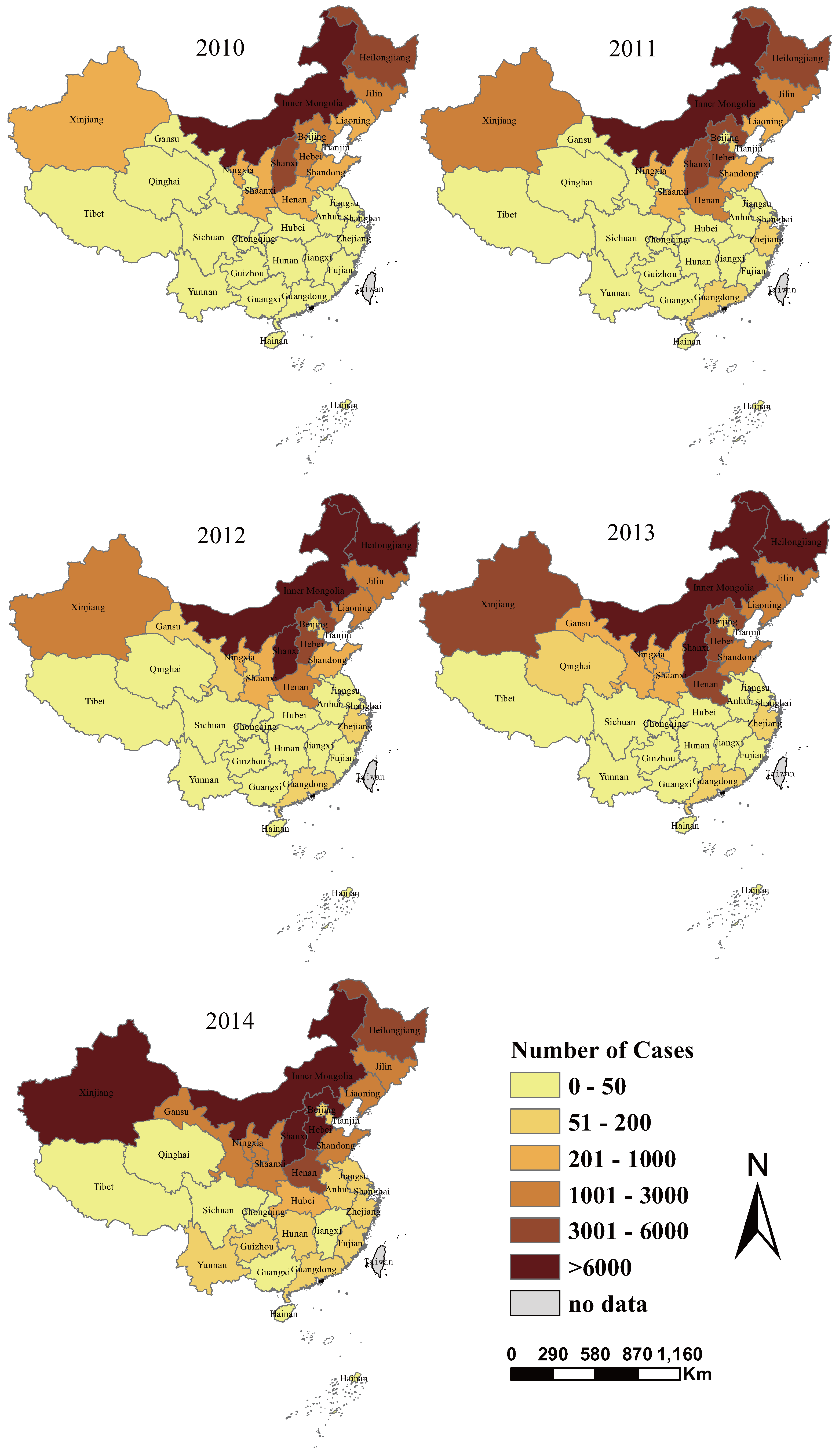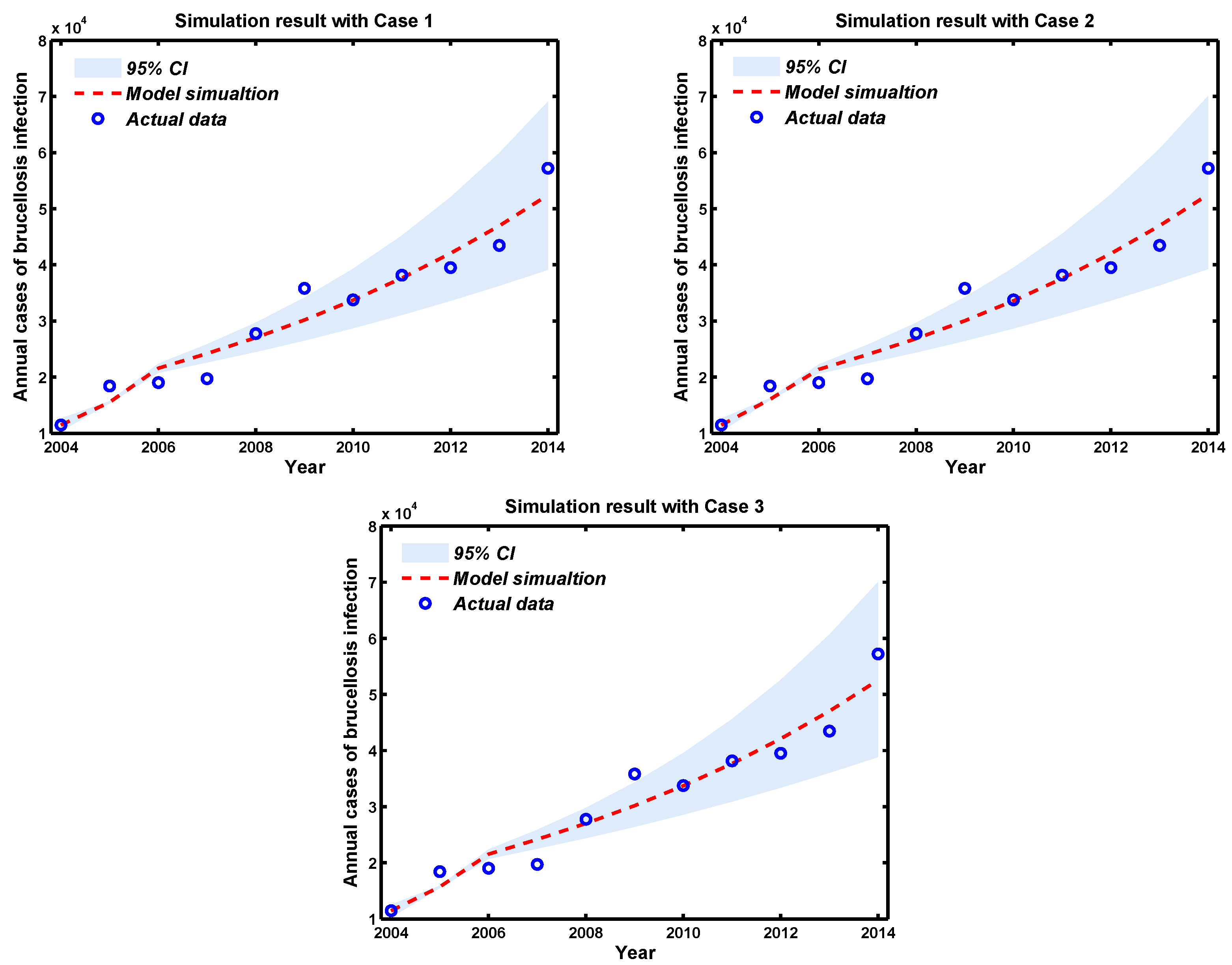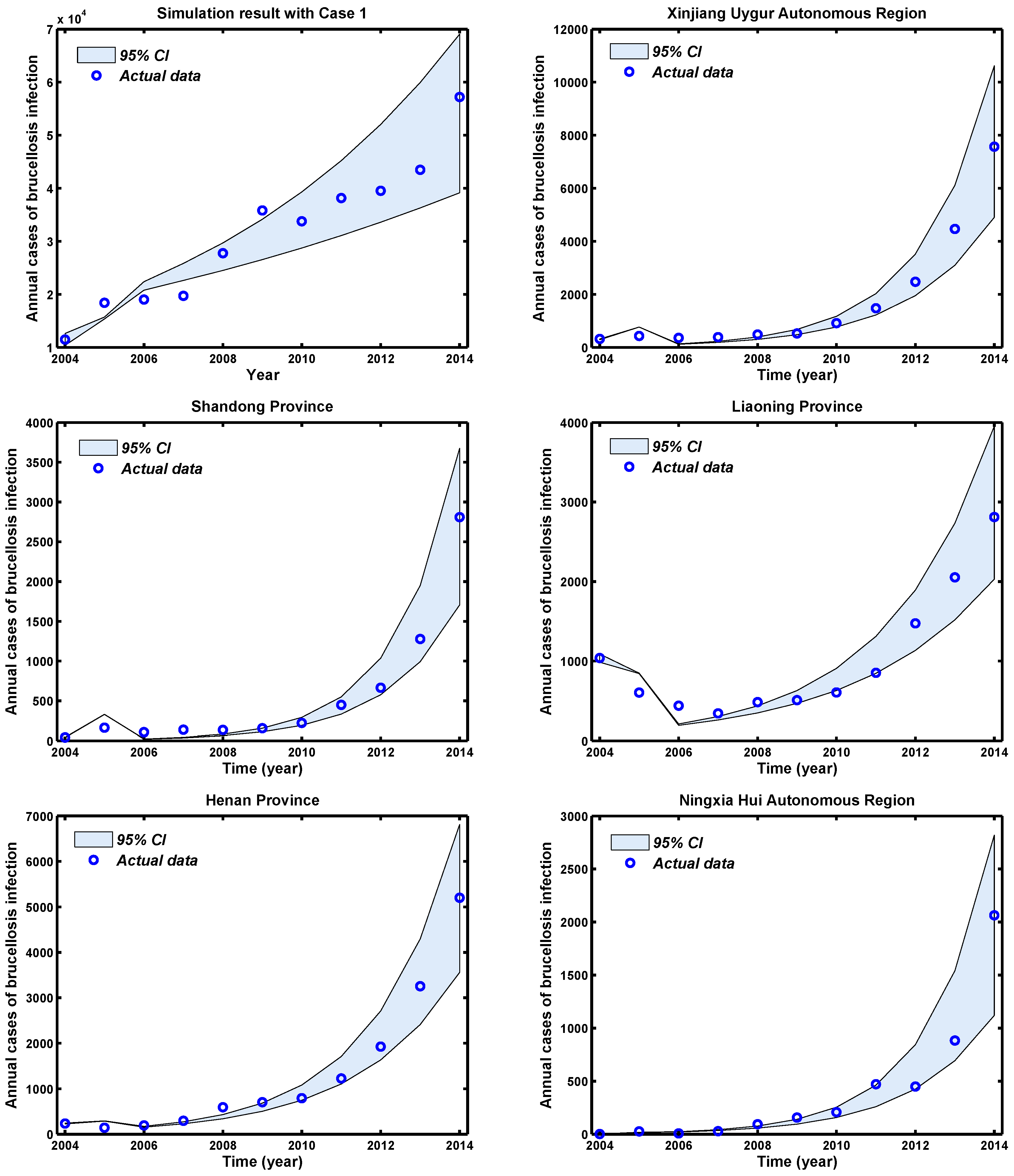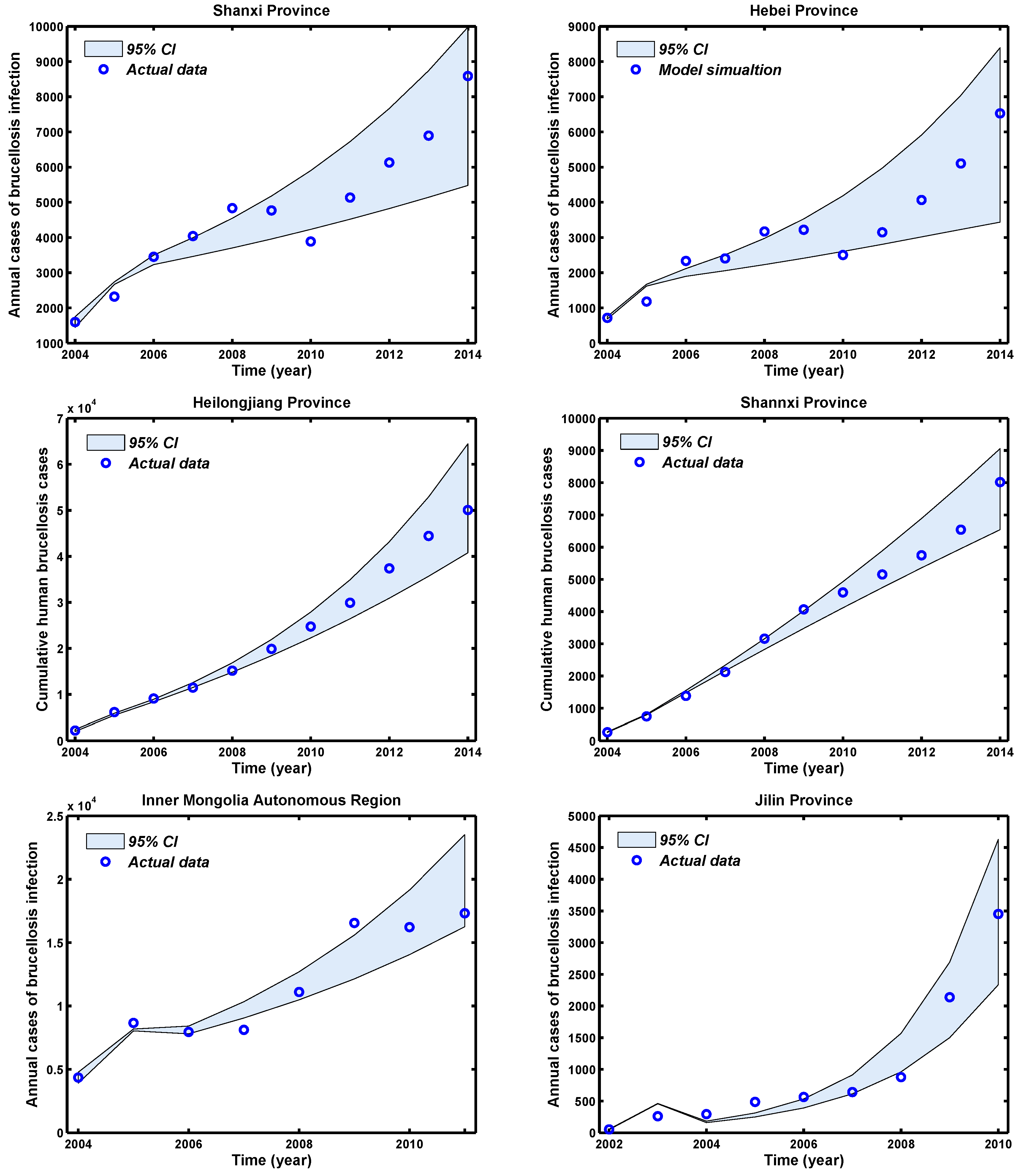Model-Based Evaluation of Strategies to Control Brucellosis in China
Abstract
:1. Introduction
2. Materials and Methods
2.1. Data Collection
2.2. Mathematical Model
3. Numerical Results
3.1. Parameter Estimation
3.2. Model Selection
3.3. Fitting Results
3.4. Estimation of Basic Reproduction Numbers
3.5. Modeling Interventions
4. Discussion
5. Conclusions
Supplementary Materials
Acknowledgments
Author Contributions
Conflicts of Interest
References
- Ariza, J.; Bosilkovski, M.; Cascio, A.; Colmenero, J.D.; Corbel, M.J.; Falagas, M.E.; Memish, Z.A.; Roushan, M.R.; Rubinstein, E.; Sipsas, N.V.; et al. Prospectives for the treatment of brucellosis in the 21st Century: The ioannina recommendations. PLoS Med. 2007, 4, e317. [Google Scholar] [CrossRef] [PubMed] [Green Version]
- Dean, A.S.; Crump, L.; Greter, H.; Schelling, E.; Zinsstag, J. Global burden of human brucellosis: A systematic review of disease frequency. PLoS Negl. Trop. Dis. 2012, 6, e1865. [Google Scholar] [CrossRef] [PubMed] [Green Version]
- Pappas, G.; Papadimitriou, P.; Akritidis, N.; Christou, L.; Tsianos, E.V. The new global map of human brucellosis. Lancet Infect. Dis. 2006, 6, 91–99. [Google Scholar] [CrossRef]
- Fosgate, G.T.; Carpenter, T.E.; Chomel, B.B.; Case, J.T.; DeBess, E.E.; Reilly, K.F. Time-space clustering of human brucellosis, California, 1973–1992. Emerg. Infect. Dis. 2002, 8, 672–678. [Google Scholar] [CrossRef] [PubMed]
- Corbel, M.J. Brucellosis in Humans and Animals; WHO: Geneva, Switzerland, 2006. [Google Scholar]
- Lucero, N.; Ayala, S.; Escobar, G.; Jacob, N. Brucella isolated in humans and animals in Latin America from 1968 to 2006. Epidemiol. Infect. 2008, 136, 496–503. [Google Scholar] [CrossRef] [PubMed]
- Meltzer, E.; Sidi, Y.; Smolen, G.; Banai, M.; Bardenstein, S.; Schwartz, E. Sexually transmitted brucellosis in humans. Clin. Infect. Dis. 2010, 51, 12–15. [Google Scholar] [CrossRef] [PubMed]
- Wyatt, H. Surgeon Captain Sheldon F. Dudley and the person to person spread of brucellosis by inhalation. JR Nav. Med. Serv. 2010, 96, 185–187. [Google Scholar]
- Doganay, M.; Aygen, B. Human brucellosis: An overview. Int. J. Infect. Dis. 2003, 7, 173–182. [Google Scholar] [CrossRef]
- Moreno, E.; Moriyón, I. The genus Brucella. In The Prokaryotes; Springer: New York, USA, 2006; pp. 315–456. [Google Scholar]
- Beauvais, W.; Coker, R.; Nurtazina, G.; Guitian, J. Policies and livestock systems driving brucellosis re-emergence in Kazakhstan. EcoHealth 2015, 1–9. [Google Scholar] [CrossRef] [PubMed]
- Corbel, M.J. Brucellosis: An overview. Emerg. Infect. Dis. 1997, 3, 213–221. [Google Scholar] [CrossRef] [PubMed]
- Dean, A.S.; Crump, L.; Greter, H.; Hattendorf, J.; Schelling, E.; Zinsstag, J. Clinical manifestations of human brucellosis: A systematic review and meta analysis. PLoS Negl. Trop. Dis. 2012, 6, e1929. [Google Scholar] [CrossRef] [PubMed] [Green Version]
- Moreno, E. Retrospective and prospective perspectives on zoonotic brucellosis. Front. Microbiol. 2014, 5, 213. [Google Scholar] [CrossRef] [PubMed]
- Roth, F.; Zinsstag, J.; Orkhon, D.; Chimed-Ochir, G.; Hutton, G.; Cosivi, O.; Carrin, G.; Otte, J. Human health benefits from livestock vaccination for brucellosis: Case study. Bull. World Health Organ. 2003, 81, 867–876. [Google Scholar] [PubMed]
- Godfroid, J.; Scholz, H.; Barbier, T.; Nicolas, C.; Wattiau, P.; Fretin, D.; Whatmore, A.M.; Cloeckaert, A.; Blasco, J.M.; Moriyon, I.; et al. Brucellosis at the animal/ecosystem/human interface at the beginning of the 21st century. Prev. Vet. Med. 2011, 102, 118–131. [Google Scholar] [CrossRef] [PubMed]
- McDermott, J.J.; Arimi, S. Brucellosis in sub-Saharan Africa: Epidemiology, control and impact. Vet. Microbiol. 2002, 90, 111–134. [Google Scholar] [CrossRef]
- Law of the People’s Republic of China on the Prevention and Treatment of Infectious Diseases. Available online: http://www.moh.gov.cn/zwgkzt/pfl/200804/29124.shtml (accessed on 28 August 2004).
- Zhong, Z.; Yu, S.; Wang, X.; Dong, S.; Xu, J.; Wang, Y.; Chen, Z.; Ren, Z.; Peng, G. Human brucellosis in the people’s republic of China during 2005–2010. Int. J Infect. Dis. 2013, 17, 289–292. [Google Scholar] [CrossRef] [PubMed]
- Li, Y.J.; Li, X.L.; Liang, S.; Fang, L.Q.; Cao, W.C. Epidemiological features and risk factors associated with the spatial and temporal distribution of human brucellosis in China. BMC Infec. Dis. 2013, 13, 547. [Google Scholar] [CrossRef] [PubMed]
- Heesterbeek, H.; Anderson, R.M.; Andreasen, V.; Bansal, S.; De Angelis, D.; Dye, C.; Eames, K.T.; Edmunds, W.J.; Frost, S.D.; Funk, S.; et al. Modeling infectious disease dynamics in the complex landscape of global health. Science 2015, 347, aaa4339. [Google Scholar] [CrossRef] [PubMed]
- Li, M.T.; Jin, Z.; Sun, G.Q.; Zhang, J. Modeling direct and indirect disease transmission using multi-group model. J. Math. Anal. Appl. 2017, 446, 1292–1309. [Google Scholar] [CrossRef]
- Beauvais, W.; Musallam, I.; Guitian, J. Vaccination control programs for multiple livestock host species: An age-stratified, seasonal transmission model for brucellosis control in endemic settings. Parasites Vectors 2016, 9, 55. [Google Scholar] [CrossRef] [PubMed]
- Lou, P.; Wang, L.; Zhang, X.; Xu, J.; Wang, K. Modelling Seasonal Brucellosis Epidemics in Bayingolin Mongol Autonomous Prefecture of Xinjiang, China, 2010–2014. BioMed Res. Int. 2016, 2016, 5103718. [Google Scholar] [CrossRef] [PubMed]
- Hou, Q.; Sun, X.; Zhang, J.; Liu, Y.; Wang, Y.; Jin, Z. Modeling the transmission dynamics of sheep brucellosis in Inner Mongolia Autonomous Region, China. Math. Biosci. 2013, 242, 51–58. [Google Scholar] [CrossRef] [PubMed]
- Li, M.; Sun, G.; Zhang, J.; Jin, Z.; Sun, X.; Wang, Y.; Huang, B.; Zheng, Y. Transmission dynamics and control for a brucellosis model in Hinggan League of Inner Mongolia, China. Math. Biosci. Eng. 2014, 11, 1115–1137. [Google Scholar] [PubMed]
- Li, M.T.; Sun, G.Q.; Wu, Y.F.; Zhang, J.; Jin, Z. Transmission dynamics of a multi-group brucellosis model with mixed cross infection in public farm. Appl. Math. Comput. 2014, 237, 582–594. [Google Scholar] [CrossRef]
- Montiel, D.O.; Bruce, M.; Frankena, K.; Udo, H.; van der Zijpp, A.; Rushton, J. Financial analysis of brucellosis control for small-scale goat farming in the Bajío region, Mexico. Prev. Vet. Med. 2015, 118, 247–259. [Google Scholar] [CrossRef] [PubMed]
- Yang, L.; Bi, Z.W.; Kou, Z.Q.; Li, X.J.; Zhang, M.; Wang, M.; Zhang, L.Y.; Zhao, Z.T. Time-series analysis on human brucellosis during 2004–2013 in Shandong province, China. Zoonoses Public Health 2015, 62, 228–235. [Google Scholar] [CrossRef] [PubMed]
- Zinsstag, J.; Roth, F.; Orkhon, D.; Chimed-Ochir, G.; Nansalmaa, M.; Kolar, J.; Vounatsou, P. A model of animal-human brucellosis transmission in Mongolia. Prev. Vet. Med. 2005, 69, 77–95. [Google Scholar] [CrossRef] [PubMed]
- Shang, D.Q.; Xiao, D.L.; Yin, J.M. Epidemiology and control of brucellosis in China. Vet. Microbiol. 2002, 90, 165–182. [Google Scholar]
- Brucellosis: clinical manifestation. Available online: http://www.chinacdc.cn/jkzt/crb/blsjb/ (accessed on 8 September 2005).
- China Animal Husbandry Yearbook Editing Committee. China Animal Husbandry Statistical Yearbook; Statistical Information; China Agriculture Press: Beijing, China, 2015. [Google Scholar]
- National Bureau of Statistics of China. China Statistical Yearbook; Human Population; China Statistics Press: Beijing, China, 2015.
- Center for Biodefense Immune Modeling, School of Medicine & Dentistry, University of Rochester. Available online: https://cbim.urmc.rochester.edu/software (accessed on 13 March 2017).
- Akaike, H. A new look at the statistical model identification. IEEE Trans. Automat. Control 1974, 19, 716–723. [Google Scholar] [CrossRef]
- Hurvich, C.M.; Tsai, C.L. Regression and time series model selection in small samples. Biometrika 1989, 76, 297–307. [Google Scholar] [CrossRef]
- Burnham, K.P.; Anderson, D.R. Model Selection and Multimodel Inference: A Practical Information-Theoretic Approach, 2nd ed.; Springer: New York, NY, USA, 2002. [Google Scholar]
- Cross, P.C.; Heisey, D.M.; Scurlock, B.M.; Edwards, W.H.; Ebinger, M.R.; Brennan, A. Mapping brucellosis increases relative to elk density using hierarchical Bayesian models. PLoS ONE 2010, 5, e10322. [Google Scholar] [CrossRef] [PubMed]
- Kunda, J.; Fitzpatrick, J.; Kazwala, R.; French, N.P.; Shirima, G.; MacMillan, A.; Kambarage, D.; Bronsvoort, M.; Cleaveland, S. Health-seeking behaviour of human brucellosis cases in rural Tanzania. BMC Public Health 2007, 7, 315. [Google Scholar] [CrossRef] [PubMed] [Green Version]
- Memish, Z.A.; Balkhy, H.H. Brucellosis and international travel. J. Travel Med. 2004, 11, 49–55. [Google Scholar] [CrossRef] [PubMed]
- Mwebe, R.; Nakavuma, J.; Moriyón, I. Brucellosis seroprevalence in livestock in Uganda from 1998 to 2008: A retrospective study. Trop. Anim. Health Prod. 2011, 43, 603–608. [Google Scholar] [CrossRef] [PubMed]
- Spira, A.M. Assessment of travellers who return home ill. Lancent 2003, 361, 1459–1469. [Google Scholar] [CrossRef]






| Case 1 | Case 2 | Case 3 | |
|---|---|---|---|
| 0.5583 (0.5522–0.5643) | 0.7401 (0.7328–0.7475) | 0.7580 (0.7545–0.7615) | |
| 0.1125 (0.1086–0.1165) | 0.2761 (0.2713–0.2809) | 0.2798 (0.2788–0.2808) | |
| 0.0676 (0.0662–0.0691) | 0.0942 (0.0924–0.0960) | 0.0752 (0.0727–0.0777) | |
| ε () | - | 1.1846 (1.1844–1.1848) | - |
| M () | - | - | 1.2911 (1.2910–1.2912) |
| 177.9735 | 180.0358 | 179.9576 | |
| 181.4021 | 186.7025 | 186.6243 | |
| Δ | 0 | 5.3004 | 5.2222 |
| 95% CI | 95% CI | 95% CI | ||||
|---|---|---|---|---|---|---|
| Mainland China | 0.6185 | (0.6118-0.6252) | 0.5193 | (0.5013–0.5475) | 1.1379 | (1.1131–1.1727) |
| Xinjiang | 0.2864 | (0.1916–0.3812) | 1.5131 | (1.4110–1.6157) | 1.7995 | (1.6025–1.9970) |
| Shandong | 0.4347 | (0.2987–0.5706) | 1.1812 | (1.0474–1.3179) | 1.6159 | (1.3461–1.8885) |
| Liaoning | 0.1886 | ( 0.1148–0.2625) | 1.2482 | (1.1835–1.3125) | 1.4369 | (1.2983–1.5750) |
| Henan | 0.2213 | (0.1694–0.2733) | 1.3132 | (1.2024–1.2789) | 1.5346 | (1.3719–1.6973) |
| Ningxia | 0.4417 | (0.2469–0.6365) | 1.2931 | (1.2013–1.8051) | 1.8348 | (1.4482–2.4417) |
| Shanxi | 0.7623 | (0.7120–0.8127) | 0.4456 | (0.3579–0.5324) | 1.2079 | (1.0699–1.3451) |
| Hebei | 0.5012 | (0.4341–0.5683) | 0.6208 | (0.5210–0.7203) | 1.1220 | (0.9550–1.2886) |
| Heilongjiang | 0.4808 | (0.4039–0.5577) | 0.6946 | (0.6183–0.7714) | 1.1754 | (1.0222–1.3292) |
| Shaanxi | 0.6708 | (0.5869–0.7546) | 0.3519 | (0.2595–0.4443) | 1.0227 | (0.8464-1.1990) |
| Inner Mongolia | 0.6135 | (0.5896–0.6375) | 0.5854 | (0.5475–0.6233 ) | 1.1989 | (1.1371–1.2608) |
| Jilin | 0.6974 | (0.4775–0.9174) | 1.0782 | (0.9005–1.2559 ) | 1.7756 | (1.3780–2.1734) |
| Vaccination Rate | Removal Rate | Disinfection Frequency () | |
|---|---|---|---|
| Mainland China | 0.1478 | 0.1245 | 3 |
| Xinjiang | 0.5418 | 0.6686 | 9 |
| Shandong | 0.4648 | 0.8132 | 8 |
| Liaoning | 0.3708 | 0.4331 | 4 |
| Henan | 0.4248 | 0.5770 | 5 |
| Ningxia | 0.5549 | 0.7108 | 11 |
| Shanxi | 0.2099 | 0.1058 | 7 |
| Hebei | 0.1326 | 0.1512 | 2 |
| Heilongjiang | 0.1820 | 0.1379 | 3 |
| Shaanxi | 0.0271 | 0.0154 | 1 |
| Inner Mongolia | 0.2023 | 0.2034 | 4 |
| Jilin | 0.5327 | 0.5847 | 19 |
© 2017 by the authors. Licensee MDPI, Basel, Switzerland. This article is an open access article distributed under the terms and conditions of the Creative Commons Attribution (CC BY) license ( http://creativecommons.org/licenses/by/4.0/).
Share and Cite
Li, M.-T.; Sun, G.-Q.; Zhang, W.-Y.; Jin, Z. Model-Based Evaluation of Strategies to Control Brucellosis in China. Int. J. Environ. Res. Public Health 2017, 14, 295. https://doi.org/10.3390/ijerph14030295
Li M-T, Sun G-Q, Zhang W-Y, Jin Z. Model-Based Evaluation of Strategies to Control Brucellosis in China. International Journal of Environmental Research and Public Health. 2017; 14(3):295. https://doi.org/10.3390/ijerph14030295
Chicago/Turabian StyleLi, Ming-Tao, Gui-Quan Sun, Wen-Yi Zhang, and Zhen Jin. 2017. "Model-Based Evaluation of Strategies to Control Brucellosis in China" International Journal of Environmental Research and Public Health 14, no. 3: 295. https://doi.org/10.3390/ijerph14030295





